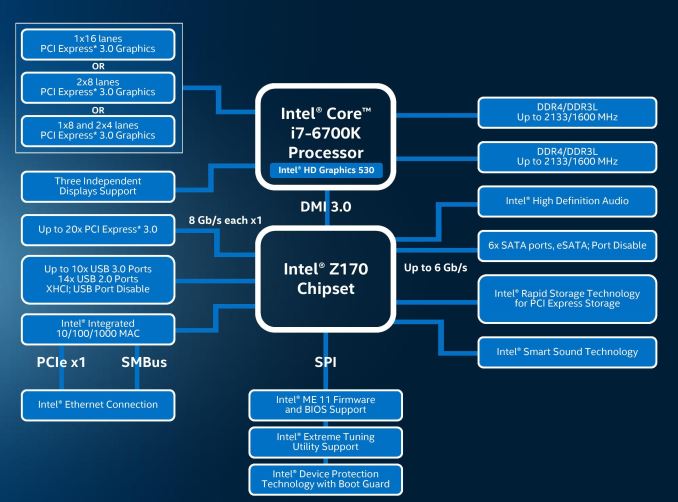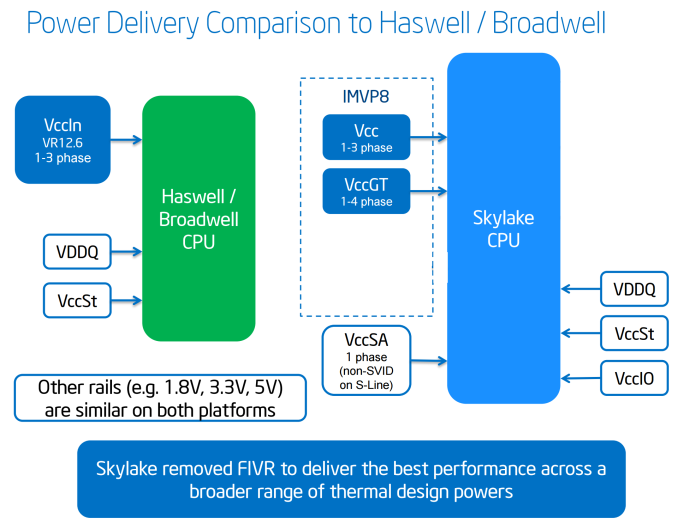The Intel 6th Gen Skylake Review: Core i7-6700K and i5-6600K Tested
by Ian Cutress on August 5, 2015 8:00 AM ESTThe Skylake CPU Architecture
As with any new Intel architecture, the devil is in the details. Previously at AnandTech we have been able to provide deep dives into what exactly is going on in the belly of the beast, although the launch of Skylake has posed a fair share of problems.
Nominally we rely on a certain amount of openness from the processor/SoC manufacturer in providing low level details that we can verify and/or explain. In the past, this information has typically been provided in advance of the launch by way of several meetings/consultations with discussions talking to the engineers. There are some things we can probe, but others are like a black box. The black box nature of some elements, such as Qualcomm’s Adreno graphics, means that it will remain a mystery until Pandora’s box is opened.
In the lead up to the launch of Intel’s Skylake platform, architecture details have been both thin on the ground and thin in the air, even when it comes down to fundamental details about the EU counts of the integrated graphics, or explanations regarding the change in processor naming scheme. In almost all circumstances, we’ve been told to wait until Intel’s Developer Forum in mid-August for the main reason that the launch today is not the full stack Skylake launch, which will take place later in the quarter. Both Ryan and I will be at IDF taking fastidious notes and asking questions for everyone, but at this point in time a good portion of our analysis comes from information provided by sources other than Intel, and while we trust it, we can't fully verify it as we normally would.
As a result, the details on the following few pages have been formed through investigation, discussion and collaboration outside the normal channels, and may be updated as more information is discovered or confirmed. Some of this information is mirrored in our other coverage in order to offer a complete picture in each article as well. After IDF we plan to put together a more detailed architecture piece as a fundamental block in analyzing our end results.
The CPU
As bad as it sounds, the best image of the underlying processor architecture is the block diagram:
From a CPU connectivity standpoint, we discussed the DDR3L/DDR4 dual memory controller design on the previous page so we won’t go over it again here. On the PCI-Express Graphics allocation side, the Skylake processors will have sixteen PCIe 3.0 lanes to use for directly attached devices to the processor, similar to Intel's previous generation processors. These can be split into a single PCIe 3.0 x16, x8/x8 or x8/x4/x4 with basic motherboard design. (Note that this is different to early reports of Skylake having 20 PCIe 3.0 lanes for GPUs. It does not.)
With this, SLI will work up to x8/x8. If a motherboard supports x8/x4/x4 and a PCIe card is placed into that bottom slot, SLI will not work because only one GPU will have eight lanes. NVIDIA requires a minimum of PCIe x8 in order to enable SLI. Crossfire has no such limitation, which makes the possible configurations interesting. Below we discuss that the chipset has 20 (!) PCIe 3.0 lanes to use in five sets of four lanes, and these could be used for graphics cards as well. That means a motherboard can support x8/x8 from the CPU and PCIe 3.0 x4 from the chipset and end up with either dual-SLI or tri-CFX enabled when all the slots are populated.
DMI 3.0
The processor is connected to the chipset by the four-lane DMI 3.0 interface. The DMI 3.0 protocol is an upgrade over the previous generation which used DMI 2.0 – this upgrade boosts the speed from 5.0 GT/s (2GB/sec) to 8.0 GT/s (~3.93GB/sec), essentially upgrading DMI from PCIe 2 to PCIe 3, but requires the motherboard traces between the CPU and chipset to be shorter (7 inches rather than 8 inches) in order to maintain signal speed and integrity. This also allows one of the biggest upgrades to the system, chipset connectivity, as shown below in the HSIO section.
CPU Power Arrangements
Moving on to power arrangements, with Skylake the situation changes as compared to Haswell. Prior to Haswell, voltage regulation was performed by the motherboard and the right voltages were then put into the processor. This was deemed inefficient for power consumption, and for the Haswell/Broadwell processors Intel decided to create a fully integrated voltage regulator (FIVR) in order to reduce motherboard cost and reduce power consumption. This had an unintended side-effect – while it was more efficient (good for mobile platforms), it also acted as a source of heat generation inside the CPU with high frequencies. As a result, overclocking was limited by temperatures and the quality of the FIVR led to a large variation in results. For Skylake on the desktop, the voltage regulation is moved back into the hands of the motherboard manufacturers. This should allow for cooler processors depending on how the silicon works, but it will result in slightly more expensive motherboards.
A slight indication of this will be that some motherboards will go back to having a large amount of multiplexed phases on the motherboard, and it will allow some manufacturers to use this as a differentiating point, although the usefulness of such a design is sometimes questionable.












477 Comments
View All Comments
boeush - Friday, August 7, 2015 - link
A good point, but I think you missed this page in the review:http://www.anandtech.com/show/9483/intel-skylake-r...
The other pages where all CPUs are normalized to 3 Ghz are for generational IPC comparison, not memory scaling. The later "what you can buy" pages repeat all the same tests but with all CPUs at full default clocks, as well - to gauge the combined effect of IPC and frequency scaling across generations.
Still missing and hopefully to be addressed in a future follow-up, is a study of generational overclocked performance, and performance under DDR4 frequency scaling with and without CPU (other than memory) overclocking.
MrSpadge - Friday, August 7, 2015 - link
Well, on the page before the one you linked Ian says:"For these tests, both sets of numbers were run at 3.0 GHz with hyperthreading disabled. Memory speeds were DDR4-2133 C15 and DDR3-1866 C9 respectively."
I think this applies to both memory scaling pages.
You've got a good point, though, that the "what you can buy" section compares DDR4-2133 and DDR3-1600 (latency unspecified) at default CPU clocks. And from a quick glance the differences there are not that different from the ones obtained in the dedicated memory scaling section.
Nutti - Friday, August 7, 2015 - link
Left out all the AMD FX processors? Looks pretty bad for AMD this way. FX is still much better than 7870K. Zen will nicely catch up with Intel. AMD needs 40% improvement over FX8350 and they will sure get that through better IPC and multithreading.Bambooz - Friday, August 7, 2015 - link
Wishful thinking from a fanboiOxford Guy - Friday, August 7, 2015 - link
Ad hominem isn't a rebuttal, bud.Oxford Guy - Friday, August 7, 2015 - link
The FX does nicely in a modern game like Witcher 3 that uses all of its threads as can be seen here: http://www.techspot.com/review/1006-the-witcher-3-...Anandtech has been doing the "let's throw in a dozen APUs and completely ignore FX" for some time now. The only thing it accomplishes is obscuring the fact that the FX can be a better value for a workstation (rendering and such) that also has some gaming requirements.
nils_ - Friday, August 7, 2015 - link
You probably should have run the Linux Tests through Phoronix Test Suite, the Linux Bench seems rather outdated with Ubuntu 11.04 (we are on 15.04 now).eeessttaa - Friday, August 7, 2015 - link
Great article as always. I wish intel would leave the fivr in it. i know how hot it got but instead of removing it they should've improved on its design.Nelviego - Friday, August 7, 2015 - link
Seems it might finally be time to OC my i7 2600k and give it another 4 1/2 years. ;)Oxford Guy - Friday, August 7, 2015 - link
Intel made everyone think Skylake was going to be a massive improvement on all fronts. Massive IPC increase. Massive technological advance. People shilled for Intel by claiming it was highly likely that Skylake wouldn't need a new socket and would just use LGA 2011-3.Instead, we get ... what? Chips that aren't significantly better than Haswells, let alone Broadwell?
I guess Intel is sandbagging even more than usual since AMD isn't doing anything new on the CPU front. So much for all of the intense Skylake hype. It amazes me, too, how people are blithely now saying "I guess I'll wait for Kaby Lake" -- the same people, often enough, who said Skylake would revolutionize computing.
It looks like this is what happens when Intel has minimal competition. The FX chips are still clinging to relevance now that consoles have 8 threads and weak individual cores (not that you'd know it based on the way this site never puts even one of them into its reviews in favor of weaker APUs) -- and because rendering programs like Blender can use their threads which can make them a decent value for budget workstation use, but their design is from 2012 or so. Overclocking is also keeping old chips like the 2500K viable for gaming.
I admit I feel for the hype a bit. I was expecting at least some sort of paradigm-shifting new tech. Instead... I don't see anything impressive at all. A new socket... a small gain in efficiency... rinse repeat.
An article I read recently said that overclocking will become increasingly non-viable as process nodes shrink. It seems we're seeing that already. The article says an Intel executive said Intel is taking overclocking seriously but the company may not have much choice.
Intel should have included hardware devoted to h.265 encoding for Skylake at least. Maybe it did, but it's not like I can tell by the charts provided. What is the point of putting in that h.265 encoding chart and not including the fastest non-E Haswell (4790K) and a Haswell-E (5820K)? It makes it look like your site is trying to hype Skylake. Don't you think people who are doing a lot of tasks like that which require serious performance (like the "slowest" setting in Handbrake) are going to need to see a comparison with the best available options?